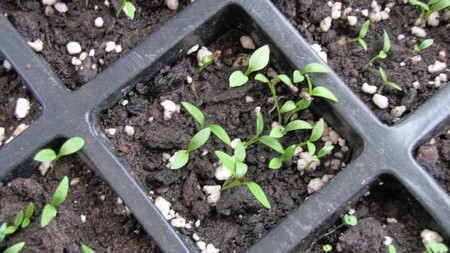Growing from seed is preferable if you require larger numbers of plants. Although it is more-work than buying pre-grown plants, it is not difficult and is much cheaper. This is particularly true for annuals, biennials, and those perennials that sprout easily, such as chives, fennel, or feverfew. Growing from seed also enables you to grow more unusual plants that might not be available at your local garden centre.
To determine the time of sowing, follow the instructions on the seed packet. Tender annuals must be started indoors, or sown outdoors after all danger of frost has passed. Other herbs can be started either outdoors or indoors. The advantage of starting seeds indoors is that germination and development can take place-earlier in the year and therefore the plants can enjoy a longer growing season.
Some herbs do not take well to being transplanted and should be sown directly into the soil where required. This particularly applies to herbs in the carrot family, such as angelica, anise, chervil, coriander, and dill, which have deep-growing roots. To grow seeds outdoors, rake the soil to produce a level, fine-textured seed bed. Scatter the seeds or sow them in drills according to the instructions on the packet, cover, and water using a nozzle with a fine rose (water breaker) or watering wand so you don’t wash away the seeds.
Some seeds will only germinate if specific-requirements are met. For example, chervil needs light to germinate and so requires minimal covering. Many perennial herbs, such as angelica, have extra-tough seed coats that have to be broken before germination is possible. This may occur naturally by the action of frost, but it may be necessary to stratify them: sow seeds in moistened vermiculite or sterile seed-starting mix, place inside a plastic bag, close with a twist tie, and refrigerate for four to twelve weeks. Some seeds benefit from being soaked in water overnight before sowing. For instance, soaking parsley seed in warm water overnight before sowing will improve the germination rate.
The traditional way of starting seeds indoors is to use a soilless growing medium (this is a commercial potting mix especially designed for starting seeds). Pour this into a shallow pot or seed tray ro a depth of 5 cm (2 inches). Firm it gently. Soak the tray in a pan of water, so that moisture is absorbed from below, and allow it to drain before sowing.
After sowing thinly and evenly, use a sieve to cover the seed with potting medium twice to three times the depth of the thickness of the seed used. Cover the tray with a sheet of glass or plastic wrap to maintain humidity, and keep it in the dark at a temperature of 21—24°C (70—75°F) until leaves begin to appear. (Heat promotes rapid germination; seeds will sprout more slowly at cooler temperatures.)
Many herb gardeners use convenient compartmentalized trays with individual seeds sown in each block. These eliminate the need to transplant crowded seedlings into larger pots and so minimize the risk of disturbing tender roots, which can severely stunt the growth of young plants.
Unless you are growing seedlings in compartmentalized trays, once the seedlings have developed a couple of pairs of leaves transplant them to 7 cm (3 inch) pots. Keep them in good light (on a sunny windowsill, or a few inches below fluorescent lights that are set to stay on for sixteen hours a day) to prevent them from becoming spindly. If they ate on a windowsill, rotate them every few days to prevent lopsided growth. Water whenever the surface of the potting medium feels dry.
When the seedlings have outgrown their pots or compartments, transplant them into larger pots filled with potting soil. Harden off the plants by moving them outdoors for a couple of hours a day at first, increasing their exposure in stages. After about two weeks of hardening off, provided the risk of frost has passed, transplant them into their final position in the garden.

